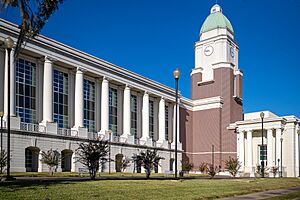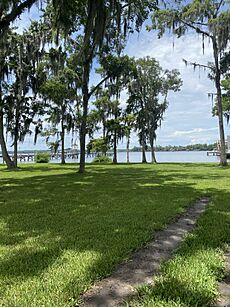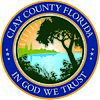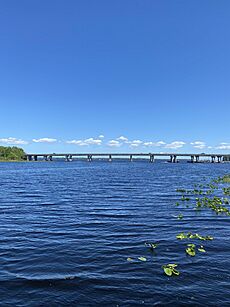Clay County, Florida facts for kids
Quick facts for kids
Clay County
|
|||
|---|---|---|---|

Clay County Courthouse
|
|||
|
|||
| Motto(s):
In God We Trust
|
|||

Location within the U.S. state of Florida
|
|||
 Florida's location within the U.S. |
|||
| Country | |||
| State | |||
| Founded | December 31, 1858 | ||
| Named for | Henry Clay | ||
| Seat | Green Cove Springs | ||
| Largest city | Lakeside | ||
| Area | |||
| • Total | 644 sq mi (1,667 km2) | ||
| • Land | 604 sq mi (1,566 km2) | ||
| • Water | 39 sq mi (101 km2) 6.1% | ||
| Population
(2020)
|
|||
| • Total | 218,245 | ||
| • Estimate
(2023)
|
232,439 |
||
| • Density | 380/sq mi (148/km2) | ||
| Time zone | UTC−5 (Eastern) | ||
| • Summer (DST) | UTC−4 (EDT) | ||
| ZIP Codes |
32003, 32043, 32065, 32068, 32073, 32079, 32091, 32234, 32656, 32666
|
||
| Area code | 352, 904, 324 | ||
| Congressional district | 4th | ||
Clay County is a county located in the northeastern part of the U.S. state of Florida along the west bank of the St. Johns River. As of 2020, the population was 218,245 and in 2023, that number increased to 232,439, making it the third largest county in the Jacksonville metropolitan area. While most of the county is unincorporated, there are 4 municipalities with Green Cove Springs being the county seat and the unincorporated Lakeside CDP being the largest place. It is named in honor of Henry Clay, a famous American statesman, member of the United States Senate from Kentucky, and United States Secretary of State in the 19th century.
Since 1990, Clay County has transformed into a largely suburban county with the third highest household median income in Florida behind neighboring St. Johns County and Santa Rosa County. This transformation has come as workers from Jacksonville, and to a smaller extent other nearby cities such as St. Augustine and Gainesville, have moved into newly built residential subdivisions. Over half of workers living in Clay County work in another county, which is the highest rate of any county in Florida. As such, the county has the third highest average commute time in the state at almost 33 minutes. With the population expected to surpass 300,000 residents by 2040, projects such as the First Coast Expressway are being constructed to alleviate chronic congestion on major roadways in the county such as Blanding Blvd and U.S. 17.
Clay County is known for its rich military history with major current and former installations such as Branan Air Field, Naval Air Station Green Cove Springs, and Camp Blanding all being located in the county. The county also attracts many tourists due to its abundance of natural water features. Many notable lakes such as Kingsley Lake, Lake Asbury, Doctors Lake, Lake Geneva, and Lake Brooklyn are all located in the county. Black Creek begins at the St. Johns River just north of Green Cove Springs and runs through the central portion of the county.
History
Early in the 19th century, Zephaniah Kingsley built his prosperous Laurel Grove Plantation, planting oranges and trading slaves, where Orange Park is today.
Clay County was created on December 31, 1858, from a section of Duval County. The area was once a popular destination for tourists because of its springs and mild climate. Steamboats brought them to various hotels in Green Cove Springs, such as the St. Elmo, Clarendon, and Oakland. President Grover Cleveland was the most prominent of such tourists and had spring water shipped to the White House. Clay County's popularity among tourists peaked during the last three decades of the 19th century. Tourism later waned because of Henry Flagler's extension of the Florida East Coast Railway to other destinations such as Palm Beach and Miami.
The military has also played an important role in Clay County history. In 1939, Camp Blanding opened on Kingsley Lake in southwest Clay County. The Florida National Guard developed this 28,000-acre (110 km2) complex. During World War II, it trained over 90,000 troops and became the fourth-largest "city" in the state. In Green Cove Springs, Lee Field was a flight training center. After World War II, Lee Field became a base for the mothball fleet. Although Lee Field closed in the early 1960s, Camp Blanding continues to operate today as a base for military training. Clay County is also a popular choice of residence for military personnel stationed on bases in nearby Duval County (NAS Jacksonville, NS Mayport, and, before it closed, NAS Cecil Field).
Geography

According to the U.S. Census Bureau, the county has a total area of 644 square miles (1,670 km2), of which 604 square miles (1,560 km2) are land and 39 square miles (100 km2) (6.1%) are covered by water. The average elevation in Clay County is 95 feet above sea level with the highest point, located on the western border in Camp Blanding, being 259 feet. The southwestern portion of the county features many lakes which contribute to the Floridan Aquifer and are an important source of water for the surrounding region. During the 2000s, high growth rates in Northeast Florida caused many of the lakes to dry up as demand for water increased. To combat this, a project began in August 2022 to construct a pipeline from Black Creek in the central part of the county to Alligator Creek in Keystone Heights. This pipeline is expected to restore the water levels in the lakes to their former high points.
Clay County is home to Goldhead Branch State Park, Belmore State Forest, and Jennings State Forest. These protected areas provide critical habitat to many native species of plants and animals, as well as provide a buffer around Camp Blanding from surrounding development.
Adjacent counties
- Duval County, Florida - north
- St. Johns County, Florida - east
- Putnam County, Florida - south
- Bradford County, Florida - west
- Baker County, Florida - northwest
Transportation
Airports
- Keystone Heights Airport
Railroads
- CSX A-Line - Runs north to south through the eastern portion of the county beginning in Orange Park to the north and exiting the county south of Green Cove Springs
- CSX S-Line - Runs very briefly through the northwest corner of the county concurrent with US-301 near Maxville
Major highways
 US 17
US 17 US 301
US 301 SR 16
SR 16 SR 21
SR 21 SR 23
SR 23 SR 100
SR 100
Before the opening of the first segment of the First Coast Expressway in 2019, Clay County was the largest county in Florida without a limited-access highway. Once complete, this project will connect Interstate 10 in Jacksonville with Interstate 95 in St. Johns County and will result in the replacement of the current Shands Bridge with a new, expanded bridge.
Public Transportation
- Clay Community Transportation - A shuttle service operated by the Jacksonville Transportation Authority with 4 lines and stops throughout the county
- Clay Express-Select - An executive-style bus service that takes riders from multiple stops in Orange Park and Fleming Island to the Jacksonville Regional Transportation Center in Downtown Jacksonville
Demographics
| Historical population | |||
|---|---|---|---|
| Census | Pop. | %± | |
| 1860 | 1,914 | — | |
| 1870 | 2,098 | 9.6% | |
| 1880 | 2,838 | 35.3% | |
| 1890 | 5,154 | 81.6% | |
| 1900 | 5,635 | 9.3% | |
| 1910 | 6,116 | 8.5% | |
| 1920 | 5,621 | −8.1% | |
| 1930 | 6,859 | 22.0% | |
| 1940 | 6,468 | −5.7% | |
| 1950 | 14,323 | 121.4% | |
| 1960 | 19,535 | 36.4% | |
| 1970 | 32,059 | 64.1% | |
| 1980 | 67,052 | 109.2% | |
| 1990 | 105,986 | 58.1% | |
| 2000 | 140,814 | 32.9% | |
| 2010 | 190,865 | 35.5% | |
| 2020 | 218,245 | 14.3% | |
| 2023 (est.) | 232,439 | 21.8% | |
| U.S. Decennial Census 1790-1960 1900-1990 1990-2000 2010-2019 |
|||
2022 Census Estimates
| Racial Composition | 2022 | 2020 | 2010 | 2000 |
|---|---|---|---|---|
| White alone (non-Hispanic) | 69.3% | 68.3% | 77.2% | 84.9% |
| Black alone (non-Hispanic) | 12.7% | 11.7% | 9.5% | 6.6% |
| Hispanic or Latino | 11.4% | 10.6% | 7.7% | 4.3% |
| Asian alone (non-Hispanic) | 3.1% | 3% | 2.8% | 2% |
| Other Race alone (non-Hispanic) | 0.6% | 1% | 0.6% | 0.6% |
| Two or more races (non-Hispanic) | 2.9% | 5.4% | 2.2% | 1.6% |
| Population | 226,589 | 218,245 | 190,865 | 140,814 |
According to 2022 census estimates, Clay County's population increased to 226,589. This increase was fueled exclusively by in-migration to the county. In all, 9,101 people have moved to Clay County since 2020 with over 95% of that growth coming from domestic migration.
Since 2020, the county has experienced 5,643 deaths compared to 4,846 births resulting in a natural change of -797. This has corresponded with an increase in the median age to 40.5 years.
2020 Census
As of the 2020 United States census, there were 218,245 people, 75,360 households, and 57,587 families residing in the county. Hispanic or Latino residents comprised 10.6% of the population or 23,134 individuals. Among those not Hispanic or Latino, 159,922 (73.3%) were White alone or in combination, 29,317 (13.4%) were Black alone or in combination, 9,510 (4.4%) were Asian alone or in combination, 4,855 (2.2%) were American Indian or Alaska Native alone or in combination, and 3,234 (1.5%) were some other race alone or in combination.
There were 85,049 housing units of which 78,939 (92.8%) were occupied.
2021 American Community Survey
According to the 2021 ACS, the median age in Clay County was 40.9 years. 25.6% of residents were 0–19 years, 11.4% were 20–29, 13% were 30–39, 13.3% were 40–49, 14.1% were 50–59, and 22.6% were 60 years and over.
There were 80,459 households in the county, of which 31.9% had children under 18 living with them, 54.6% were married couples living together, and 38.3% were individual householders with no spouse or partner present. The average household size was 2.75 and the average family size was 3.15.
The median income for a household in the county was $76,679, and the median income for a family was $85,196. Males had a median income of $47,393 versus $35,103 for females. The per capita income was $33,364. About 7.1% of the population were below the poverty line including 13.5% of those under age 18 and 6% of those age 65 and over.
The ten largest reported ancestry groups in the county were Irish (11.7%), English (11.6%), German (10.7%), American (4.7%), Italian (3.5%), Scottish (3.1%), French (2.2%), Polish (1.9%), European (1.5%), and Scotch-Irish (1.1%).
45% of residents were born in Florida and 46% were born in another state. The majority of in-migration comes from other Southern states and the Northeast. There is a growing community of Puerto Ricans in Clay County, with the number of residents born on the island numbering 3,590.
Clay County has the second highest percentage of Filipino immigrants in Florida, after neighboring Duval County, with 1.1% of residents hailing from the Philippines. In total, 6.1% of residents were foreign-born with over 68% being naturalized citizens and the majority entering the United States prior to 2010.
| Foreign-born
Population in Clay County |
Percentage of
Clay County Population |
Foreign-born
Population in Florida |
Percentage of
Florida Population |
|
|---|---|---|---|---|
| Philippines | 2,449 | 1.1% | 88,318 | 0.4% |
| Mexico | 1,097 | 0.5% | 287,765 | 1.3% |
| Cuba | 715 | 0.3% | 973,959 | 4.5% |
| Haiti | 645 | 0.3% | 341,943 | 1.6% |
| Peru | 534 | 0.3% | 89,858 | 0.4% |
| Canada | 492 | 0.2% | 94,586 | 0.4% |
| El Salvador | 489 | 0.2% | 43,975 | 0.2% |
| Guatemala | 436 | 0.2% | 102,110 | 0.5% |
| India | 429 | 0.2% | 97,800 | 0.5% |
| China | 408 | 0.2% | 48,308 | 0.2% |
| Language Spoken at Home | 2019 | 2010 | 2000 | 1980 |
|---|---|---|---|---|
| English | 89.3% | 90.5% | 92.3% | 96.4% |
| Spanish | 6.4% | 5.2% | 4.2% | 1.4% |
| Tagalog | 1.4% | 1% | 0.9% | 0.3% |
| German or West Germanic Languages | 0.6% | 0.4% | 0.5% | 0.4% |
| French, Haitian, or Cajun | 0.5% | 0.6% | 0.5% | 0.4% |
| Other Languages | 1.8% | 2.3% | 1.6% | 1.1% |
Museums
- Clay County Historical and Railroad Museum, Green Cove Springs
- Middleburg Historical Museum, Middleburg
- Black Heritage Museum, Middleburg
- Camp Blanding Museum, Camp Blanding
Education
The Clay County School District operates 42 public schools, with currently 28 elementary schools, five junior high schools, six high schools, and one junior/senior high school.
As of the 2021-22 school year, the school district received an "A" grade from the Florida Department of Education and was ranked the tenth top school district in the state. In 2023, U.S. News and World Report ranked Fleming Island High School the top high school in Clay County and 91st in Florida.
Libraries
The Clay County Public Library System consists of five branches:
- Green Cove Springs Library
- Headquarters Library (Fleming Island)
- Keystone Heights Library
- Middleburg-Clay Hill Library
- Orange Park Library
The first public library in Clay County was made up of a small collection established by the Village Improvement Association within the county. Other small libraries were established by other organizations within Clay County. In 1961, representatives from different women's organizations in the county started a movement to establish a library system within the county, and resulted in the Clay County Board of County Commissioners beginning to set aside funds to create the county library system. Due to their efforts, the first public library in Clay County was opened in 1961 in Green Cove Springs. The Green Cove Springs Library purchased a bookmobile in 1962 and began to provide outreach services to different areas within Clay County that same year. In 1962 two more public libraries opened in Clay County, the Keystone Heights Library and the Orange Park Library. A fire destroyed the Keystone Heights Library in February 1962. The Keystone Heights Library was relocated to a new building in Theme Park in 1964. The Headquarters Library in Green Cove Springs became open to the public in 1970 after a population boom caused the need for a new library. In 1976, the Orange Park Library moved to a larger location within the town of Orange Park. The population growth experienced in the county during the late 1970s necessitated the development of the Middleburg-Clay Hill Library, which first opened in a storefront in the late 1970s. The permanent facility for this library was completed and opened to the public in 1986.
Communities
Cities
Towns
Census-designated places
Other unincorporated communities
See also
 In Spanish: Condado de Clay (Florida) para niños
In Spanish: Condado de Clay (Florida) para niños




